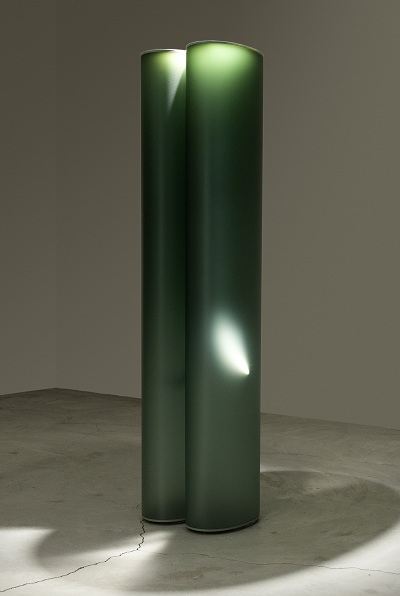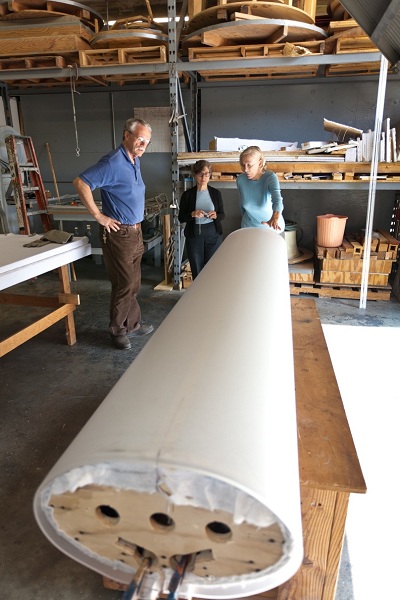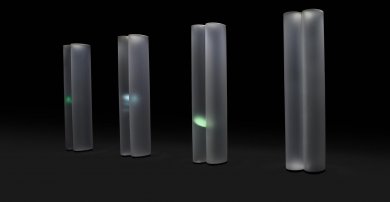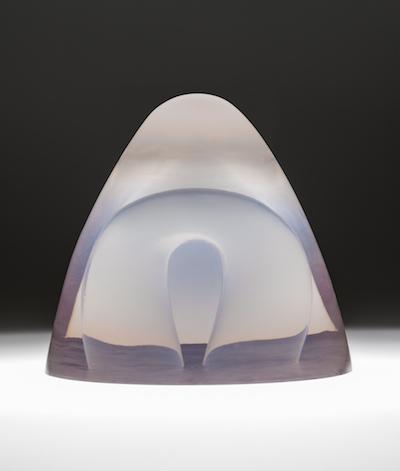How do you represent a work of art that doesn’t yet exist? For LACMA’s upcoming exhibition Helen Pashgian: Light Invisible (March 30–June 29, 2014), the artist is making a new large-scale sculpture consisting of 12 molded acrylic columns that will be displayed in the special exhibition galleries of the Art of the Americas Building. Before the work is installed on-site at LACMA, however, no one—not even the artist herself—will be able to see the sculptural installation in its entirety. Due to the space and lighting conditions it requires, only a portion of the work can be assembled in the artist’s studio at any one time.
For the staff at LACMA, projects like this one pose interesting challenges. One question, for example, is what photo or image we should use to represent the work of art in our advance publicity materials (such as our website, press release, and exhibition announcement), considering that it can’t be photographed until it is on view. To work through this question, members of our curatorial and communications departments recently came together to talk about how we should represent the exhibition in the absence of the artwork itself. Here, you can see for yourself some of the images we looked at and considered.
One possibility is to use another work by Pashgian as a stand-in. LACMA owns Untitled (1968–69), a small sculpture made of cast resin with an acrylic insert. This object, from early in Pashgian’s career, shares important traits with her upcoming installation despite its differences in scale and form: both investigate the physical properties of their respective materials, and both have the ability to enthrall the viewer through their mysterious refraction and reflection of light. Another sculpture in LACMA’s collection, Untitled (2011), relates even more closely to Untitled (2014). The 2011 work is a two-part column similar in form and construction (although not color) to the columns that will constitute the exhibition. Neither of these permanent-collection pieces will be included in Helen Pashgian: Light Invisible, however, so using an image of either object runs the risk of being misleading about the content of the show.
 Helen Pashgian, Untitled, 1968–69, purchased with funds provided by the Hillcrest Foundation and the Modern and Contemporary Art Council Acquisitions Endowment
Helen Pashgian, Untitled, 1968–69, purchased with funds provided by the Hillcrest Foundation and the Modern and Contemporary Art Council Acquisitions Endowment
 Helen Pashgian, Untitled, 2011, anonymous gift
Helen Pashgian, Untitled, 2011, anonymous gift
Another option is to use a photograph showing the fabrication process for Untitled. In 2012, curator of Modern Art Carol S. Eliel accompanied Pashgian to her fabricator’s studio to observe how the artist makes her molded acrylic forms. LACMA photographer Peter Brenner took a series of photographs that day documenting the fabrication of a single column. While these photographs provide an illuminating visual narrative of Pashgian’s working methods (a selection of them will be included in the book accompanying the exhibition), it is hard to choose a single image from the series to represent the installation as a whole.
 Curator of Modern Art Carol S. Eliel (center) discusses the fabrication process with artist Helen Pashgian (right) and her fabricator. Photo by Peter Brenner
Curator of Modern Art Carol S. Eliel (center) discusses the fabrication process with artist Helen Pashgian (right) and her fabricator. Photo by Peter Brenner
Finally, a partial mock-up of Untitled was photographed earlier this year in Pashgian’s studio. This detail offers a tantalizing preview of the LACMA installation, but it is definitely a photo of a work in process—in addition to showing only four of the installation’s 12 columns, the spacing between the components is different from how it will be in the final presentation.
 Helen Pashgian, Untitled (detail of work in process in the artist’s studio), 2012–13, © 2014 Helen Pashgian, photo © 2014 Josh Morton
Helen Pashgian, Untitled (detail of work in process in the artist’s studio), 2012–13, © 2014 Helen Pashgian, photo © 2014 Josh Morton
As you can see, each potential image has its strengths and drawbacks. What image would you choose to represent Helen Pashgian: Light Invisible?
Jennifer King, Wallis Annenberg Curatorial Fellow, Modern Art



